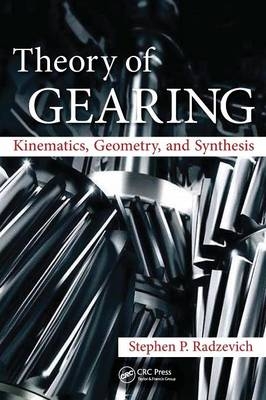
Theory of Gearing
Crc Press Inc (Verlag)
978-1-4665-1448-5 (ISBN)
- Titel erscheint in neuer Auflage
- Artikel merken
The proposed theory is based on a key postulate: all the design parameters for an optimal gear pair for a particular application can be derived from (a) a given configuration of the rotation vectors of the driving and driven shafts and (b) the power transmitted by the gear pair. This allows engineers to synthesize the desired gear pairs with only the following input information:
The rotation and torque on the driving shaft
The configuration of the driven shaft in relation to the driving shaft
The desired rotation and torque of the driven shaft
Beginning with the fundamentals, the book reconsiders the basic theory of kinematics and geometry of gears to provide a sound basis for the evaluation and development of future designs. It then examines ideal and real gearing for parallel-axis, intersected-axis, and crossed-axis gearing. The book addresses how to minimize vibration and noise in gears, discusses aspects of implementing the theory of gearing, and analyzes principal features of power transmission and the loading of gear teeth. More than 500 figures clearly illustrate the principles.
This is an invaluable resource for engineers and researchers who work in gear design, gear production, and the application of gears as well as for students in mechanical and manufacturing engineering. Covering all known gear designs, this book offers an analytical solution to the problem of designing optimal gear pairs for any given application. It also encourages researchers to further develop the theory of gearing.
Dr. Stephen P. Radzevich is a professor of mechanical engineering and manufacturing engineering. He has extensive industrial experience in gear design and manufacture and has developed numerous software packages dealing with computer-aided design (CAD) and computer-aided manufacturing (CAM) of precise gear finishing for a variety of industrial sponsors. Dr. Radzevich has spent over 35 years developing software, hardware, and other processes for gear design and optimization. Besides his industry work, he trains engineering students at universities and gear engineers in companies. He has authored and coauthored over 30 monographs, handbooks, and textbooks, including Kinematic Geometry of Surface Machining (CRC Press, 2007), Gear Cutting Tools: Fundamentals of Design and Computation (CRC Press, 2010), and Dudley’s Handbook of Practical Gear Design and Manufacture (CRC Press, 2012). He has also authored and coauthored over 250 scientific papers and holds more than 200 patents on inventions in the field.
Synthesis
Kinematics of a Gear Pair
Geometry of Gear Tooth Flanks: Preliminary Discussion
Geometry of Contact of Tooth Flanks of Two Gears in Mesh
Concept of Synthesis of a Gear Pair with Prescribed Performance
Ideal Gearing: Parallel-Axis Gearing
Involute Gearing
Noninvolute Gearing
High-Conforming Parallel-Axis Gearing
Synthesis of Optimal Parallel-Axis Gearing
Ideal Gearing: Intersected-Axis Gearing
Geometrically Accurate Intersected-Axis Gear Pairs
High-Conforming Intersected-Axis Gearing
Ideal Gearing: Crossed-Axis Gearing
Geometrically Accurate Crossed-Axis Gearing: R-Gearing
High-Conforming Crossed-Axis Gearing
Ideal (Geometrically Accurate) Two-Degree-of-Freedom Gearing
Kinematics, Geometry, and Design Features of 2-DOF Gearing
Real Gears and Their Application: Real Gearing
Desired Real Gearing: Spr-Gearing
Approximate Real Gearing
Generic Gear Shape
Gear Noise
Real Gears and Their Application: Gear Trains
Gear Ratio of a Multistage Gear Drive
Split Gear Drives
Real Gears and Their Application: Principal Features of Power Transmission and Loading of the Gear Teeth
Local Geometry of the Interacting Tooth Flanks
Contact Stresses in Low-Tooth-Count Gearing
Application of the Results Derived from Theory of Gearing
Conclusion
Appendix A: Elements of Coordinate Systems Transformations
Appendix B: Novikov’s Gearing Invention Disclosure
Appendix C: Wildhaber’s Gearing Invention Disclosure
Appendix D: Engineering Formulas for the Specification of Gear Tooth Flanks
Appendix E: Change of Surface Parameters
Appendix F: Notations
Appendix G: Glossary
References
Bibliography
Index
| Zusatzinfo | 900 + equations; 20 Tables, black and white; 513 Illustrations, black and white |
|---|---|
| Verlagsort | Bosa Roca |
| Sprache | englisch |
| Maße | 178 x 254 mm |
| Gewicht | 1520 g |
| Themenwelt | Naturwissenschaften ► Physik / Astronomie ► Mechanik |
| Technik ► Maschinenbau | |
| ISBN-10 | 1-4665-1448-5 / 1466514485 |
| ISBN-13 | 978-1-4665-1448-5 / 9781466514485 |
| Zustand | Neuware |
| Haben Sie eine Frage zum Produkt? |
aus dem Bereich



